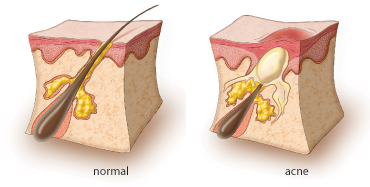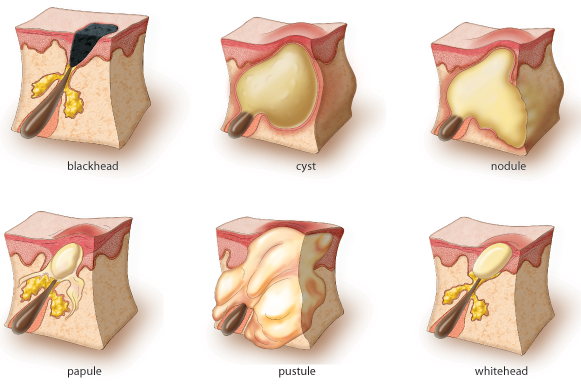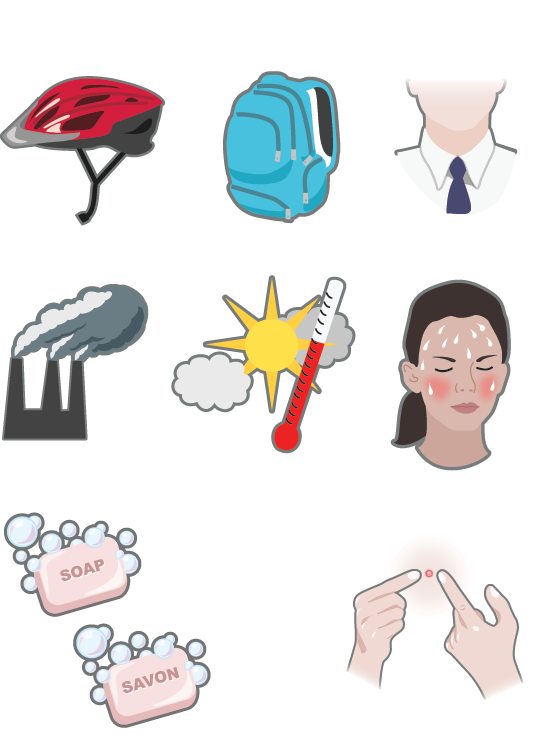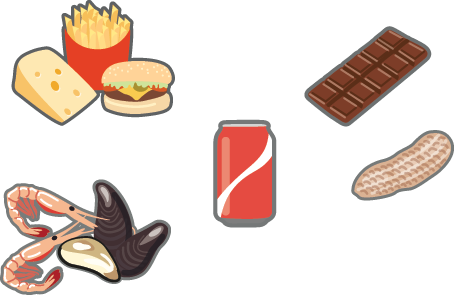About Acne
WHAT IS ACNE?
Human skin is covered in hundreds of thousands of microscopic hair follicles, called pores. These are particularly prominent on the face, neck, back, and chest. These pores are connected to oil glands under the skin that make a substance called sebum. Sometimes these follicles produce too many cells and become blocked. As a result, sebum (oil) gets trapped and bacteria (P. acnes) begin to grow.1,2,4
Acne is the most common skin condition.1,4

SYMPTOMS AND SIGNS OF ACNE
- Pimples usually occur on the face, neck, back, chest, and shoulders.1

- Acne pimples can be categorized into two main types: non-inflammatory (whiteheads and blackheads) and inflammatory (papules, pustules, cysts, and nodules).2
- There are many types of pimples1,2:
- Whiteheads are pimples in which the trapped sebum and bacteria stay under the surface of the skin. These are very small.
- Blackheads are pimples that rise to the skin's surface. Once at the surface, the sebum oxidizes and turns a dark brown/black colour.
- Papules appear as small pink bumps. They are the result of a break in the wall of the follicle; the pore fills with white blood cells and is inflamed.
- Pustules appear as red pimples with pus at the top. Papules eventually become pustules, when the white blood cells make their way to the surface of the skin.
- Nodules are painful pimples deep in the skin, resulting from a break in the bottom of the follicle.
- Cysts are deep pus-filled pimples that can cause scars.

- There are four types of severe acne2:
- Acne conglobata – More common in males, this involves numerous large lesions and can cause irrevocable damage to the skin.
- Acne fulminans – Normally seen in young Caucasian men, this severe nodulocystic acne is associated with fever and painful joints. It can cause disfiguring scarring.
- Gram-negative folliculitis – Characterized by pustules and cysts, this type of acne can be the result of long-term antibiotic treatment of acne vulgaris.
- Pyoderma faciale (rosacea fulminans) – Affecting only females, this acne is characterized by painful nodules and pustules. It can begin suddenly, and usually runs its course within a year.

WHY DO PEOPLE GET ACNE?
- Why people get acne is unknown. However, there are some contributing factors: increases or changes in hormones (for example, during adolescence or pregnancy), heredity, some medications, and greasy makeup.1

- Some things can make acne worse1,4: examples include physical pressure from bike helmets, backpacks, and tight collars; pollution; humidity; sweating; overwashing your skin; and scrubbing or picking at your skin.

- Several things have been rumoured to cause acne, but actually do not1,3,4:
- Dirty skin
- Stress
- Eating chocolate, greasy foods, peanuts, or shellfish, or drinking colas. These foods do not cause acne in most people. However, if you personally find that a particular food aggravates your acne, just stop eating it.

WHO GETS ACNE?
- Acne is most common in teenagers and young adults, but people of all races and ages can get it.1
- Acne typically presents during puberty because of the surge in sex hormones during that time. It can last for 5–10 years, and sometimes continues on into adulthood.4
- Babies can get acne. This occurs in about 20% of newborns and usually resolves within a few weeks to 3 months.4
WHAT IS A DERMATOLOGIST?
- A dermatologist is a doctor who works with patients who are having problems with their skin.
- If your acne is stubborn or one of the more severe types, your family doctor may refer you to a dermatologist for treatment.
WHAT IS THE PROGNOSIS?
- Acne is not a serious health threat. However, it can result in scars.1
- The best way to prevent scarring is to treat acne early.1
- One of the main concerns for people with acne is that they are embarrassed by it.
ARE THERE TREATMENTS FOR ACNE?
On the horizon
- Current research on acne is looking into new drugs to treat it, ways to prevent it from occurring, and understanding more about the skin's bacteria.1
REFERENCES
- US National Institute of Arthritis and Musculoskeletal and Skin Diseases. What is acne? Bethesda (MD): The Institute, 2010; http://www.niams.nih.gov/health_info/acne/acne_ff.pdf. Accessed January 18, 2013.
- Acne.org. What is acne? San Francisco (CA): Daniel Kern Inc, n.d.; http://www.acne.org/whatisacne.html. Accessed January 18, 2013.
- SkinCarePhysicians.com. Frequently asked questions about acne. Schaumburg (IL): American Academy of Dermatology, 2011; http://www.skincarephysicians.com/acnenet/faq.html. Accessed January 21, 2013.
- Canadian Dermatology Association. Acne. Ottawa (ON): The Association, n.d.; http://www.dermatology.ca/skin-hair-nails/skin/acne/. Accessed January 23, 2013.
